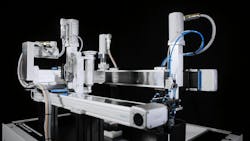Fluid Power Industry Continues to Navigate Market Challenges While Embracing New Opportunities
Key Highlights
- Trade policy uncertainties created several challenges for the fluid power industry in 2025.
- While some of these challenges will persist into 2026, hydraulics and pneumatics companies are finding areas of opportunity such as automation and data centers.
- Demand for smart, connected components and AI integration is on the rise and will transform fluid power systems in the years to come.
The hydraulics and pneumatics industry, like many sectors, faced challenging market conditions in 2025. Trade policy uncertainty, high interest rates and geopolitical factors all contributed to the decreased demand many fluid power companies and their customers experienced during the year.
Despite these challenges, some new opportunity markets have emerged for the fluid power industry, such as data centers. In addition, automation and other industry trends are helping bring new technology developments and use cases to the hydraulics and pneumatics sector.
To get a better understanding of how various economic and technology trends impacted the fluid power industry in 2025, Power & Motion spoke with representatives from the hydraulics and pneumatics sector who also provided their thoughts on potential challenges and opportunities facing the industry in the coming year.
*Editor’s note: Questions and responses have been edited for clarity.
Power & Motion: How has 2025 been for your company and the fluid power industry as a whole? What have been some of the biggest challenges faced this year, and what opportunities have you seen?
Ken Baker, CEO, Bailey: The overall business through the first half of 2025 was still struggling from the post-COVID fall-off. We saw slight improvements over the second half of 2025, but small gains. Organizationally we still saw a lot of fatigue left over from the supply chain regularization of COVID. That has eased now.
The biggest challenges are tariffs and the uncertainty caused by them. The shifting landscape has not offered stability for understanding optimal domestic and overseas production locations.
The markets are generally not supportive of growth. We have, though, seen growth through straightforward sales and opportunity wins. We have worked hard over the past 18 months to improve internal operations and sales education. We have expanded our product range and technical offerings in the market. We have worked hard on our CRM (customer relationship management) and sales management functions. All these efforts have yielded wins with our existing and new customers.
Camozzi Automation – USA Branch: 2025 has been a year of both navigating macroeconomic uncertainty and looking for growth opportunities. On the broader fluid power front, one of the challenges is the tension between legacy pneumatic systems and the demand for smart electro-pneumatic systems.
Robotics, electric actuation, and system connectivity have been the focus over the past couple of years, so finding where one fits has been important.
Frank Langro, Director – Product Market Management, Pneumatic Automation, North America, Festo Corp.: 2025 has been a volatile year for the fluid power industry. The only consistency we’ve seen is the continued unpredictability of the market. The National Fluid Power Association (NFPA) reports the total fluid power market (pneumatic and hydraulic) being down in both orders and shipments, and that is what we see. After a strong start to the year, Festo experienced a slowdown beginning in Q2. Recently, we have seen a positive uptick and are cautiously optimistic for 2026.
The market dynamics of unpredictable tariffs have caused issues for both our customers and us. Cost structures were turned on their heads as supply chains had to be thoroughly reevaluated to understand the impact of the tariffs. This had to be done down to raw materials, not simply components and finished goods.
The industry is also adjusting to governmental policy changes. For example, investments in EVs (electric vehicles) and even sometimes battery facilities have been scaled back. This has had a negative impact on the machine builders.
Even within the current environment, there are reshoring opportunities. For example, companies are dealing with labor shortages, and so the demand for automation is rising.
While the automotive industry is slowing down, there is growth in data centers and all the ancillary systems that surround those centers and that require various forms of automation.
Power & Motion: How have tariffs impacted your company and the fluid power industry in general this year? How has your company navigated the tariff landscape, and do you anticipate tariffs will continue to present challenges in 2026?
Ken Baker, Bailey: Tariffs have definitely impacted the fluid power industry overall. Even domestic manufacturers imported subcomponents, which caused a lot of uncertainty. Overseas finished products have also seen tariff and location changes across the board. We manufacture both domestically and internationally, so we have had to deal with both areas of concern.
Visit our Market Trends channel for even more content related to economic and technology trends impacting the fluid power and electromechanical motion control sectors. You can also sign up for our Market Trends eNL to have this content delivered directly to your inbox.
Our biggest response was to move most of our production out of China, into other Asian countries. We had started this process with the tariff implementations in 2018. We were, therefore, very flexible. Bailey's supply chain teams worked very diligently and rapidly amid changing rules and values. These changes have put our customers in the best position possible.
I anticipate that tariffs will continue to be a challenge, though we appear to be approaching some levels of stability now.
Camozzi Automation: Like many global manufacturers, we continue to monitor and manage the impact of tariffs. The shifting landscape of trade policies adds complexity to our sourcing and manufacturing decisions, especially in cross-border production. That said, our global diversified footprint helps buffer some of that risk.
Frank Langro, Festo: Many companies within fluid power have been stressed by tariffs. For example, most companies rely on a global supply chain for various items that go into producing their products. Foremost of these are aluminum, stainless steel, and copper — the metals that are used in the construction of cylinders and valves. From raw materials on up, there was a scramble to adjust.
Festo took a cautious approach, holding its prices at the previous year's levels. In September we made strategic adjustments and were able to maintain prices on our key products that make up the Festo FAST (in stock and ready to ship) inventory program.
Challenges will still exist in 2026 because of the unpredictability of tariffs. With a year into this new environment, Festo has tuned its processes for quicker evaluation and precise responses to a level not possible at the start of the turbulence.
Watch our video below to learn more about how tariffs have been impacting fluid power and other industries.
Power & Motion: What are the most requested features or capabilities you’ve been getting from customers this year, and how, if at all, do they fit in with broader industry-wide trends?
Ken Baker, Bailey: We are seeing more requests for more complex product implementations. Part of this is due to the focus we have had in improving our technical capabilities to serve the market and part of it is from customers wanting to have more technical solutions with more functions in small spaces. Examples of this are seen in the increased number and complexity of manifolds and valve solutions, in increases in sensor cylinder requests, and in higher-flow and higher-pressure systems.
Camozzi Automation: Customers are increasingly asking for smart, connected components (e.g., IO-Link devices). New designs have to be done to be efficient, versatile, and sustainable across multiple industries.
Frank Langro, Festo: We continue to see the blending of technologies along with the “electrification” of pneumatics in the automation field. Customers continue to use industrial networks and want network-enabled products such as valve terminals, proportional valves, and sensors. This trend supports bringing communication and intelligence to the machines and enabling advanced monitoring and analytics.
AI (artificial intelligence) technologies are enablers and help to facilitate the evaluation of massive amounts of data for precise decision making. Because machines can provide more real-time data, industry will see fewer unplanned shutdowns and an overall increase in quality, improvements to productivity, and lower waste.
Power & Motion: Are there any new trends you see influencing the fluid power industry in 2026 and beyond? If so, what are those trends and how do you anticipate them impacting fluid power designs and/or the industry?
Ken Baker, Bailey: I believe we will see a continued increase in complexity.
We have also seen more customers are asking that we perform greater levels of engineering and technical support. As customers try to do more with less people, they are turning to key suppliers to help with the engineering and manufacturing workloads.
We are also seeing more uses of AI, internally with ourselves and externally with our suppliers. This work to date has been focused on improving engineering and operational processes. Not a lot of this is driven from customers, but I would expect this trend to continue strongly in 2026. I expect this will impact customer-facing systems in 2026.
Camozzi Automation: Yes, there are several strong trends shaping the future of fluid power. Smart connectivity, electrification, sustainability, modularity, and workforce digitalization are not just buzzwords: they are actively influencing how fluid power systems will be designed, built, sold, and maintained.
For Camozzi Automation U.S., these trends present a real opportunity to lead with innovation, deliver more value to customers, and position ourselves for long-term, sustainable growth.
Frank Langro, Festo: I wouldn’t say anything revolutionary has appeared, but the natural progression of Smart Manufacturing/Industry 4.0 concepts continues to evolve with more prevalent use of AI and digitalization.
Power & Motion: What opportunities do you see for the fluid power industry in 2026? Are there any markets you anticipate doing well or offering areas of opportunity in the coming year?
Ken Baker, Bailey: With reductions in interest rates and a focus on reducing regulatory overhead, I am hoping to see a pick-up in residential housing construction. I also expect that multi-family housing construction will grow. We are hoping that this will pick up the forestry industry, along with a positive construction pick-up.
Work truck markets seem stable, and we expect growth in this area in 2026. Work trucks cover a wide variety of areas (from waste handling to utilities to construction).
I believe agriculture equipment markets will continue to struggle through the first half of 2026. Beyond this, I do not have a lot of vision of where this market will go. Replacement and repair components will be the key drivers early.
Non-residential construction appears to be stable. The general warehousing boom has rolled off, but data-center construction has boomed (with the help of AI). Construction has increased as a percentage of our business and we expect this to continue.
Camozzi Automation: Opportunities exist in development of new materials for cost reductions, lighter weights, environmental considerations. We will continue to see consolidations and acquisitions across the industry as companies look to expand their portfolios.
The transportation market continues to be a focus area for Camozzi Automation. As vehicles get more advanced and more efficient, demand for reliable fluid control in braking, suspension, and energy systems will remain strong.
Frank Langro, Festo: The skilled labor shortage continues to be a problem for manufacturers, and automation is certainly part of the solution. For over 50 years, Didactic, the training arm of Festo, has been working to close the skills gaps. We know that demand for Didactic services will continue to accelerate.
There are always bright spots within the markets. We see the Life Sciences market as offering growth opportunities because the need for lab automation continues to rise. As mentioned earlier, the growth of data centers will spur the need for automation to support the ancillary systems around those centers. The growth of highly automated semiconductor fabs is another bright spot.
About the Author
Sara Jensen
Executive Editor, Power & Motion
Sara Jensen is executive editor of Power & Motion, directing expanded coverage into the modern fluid power space, as well as mechatronic and smart technologies. She has over 15 years of publishing experience. Prior to Power & Motion she spent 11 years with a trade publication for engineers of heavy-duty equipment, the last 3 of which were as the editor and brand lead. Over the course of her time in the B2B industry, Sara has gained an extensive knowledge of various heavy-duty equipment industries — including construction, agriculture, mining and on-road trucks —along with the systems and market trends which impact them such as fluid power and electronic motion control technologies.
You can follow Sara and Power & Motion via the following social media handles:
X (formerly Twitter): @TechnlgyEditor and @PowerMotionTech
LinkedIn: @SaraJensen and @Power&Motion
Facebook: @PowerMotionTech

Leaders relevant to this article:




